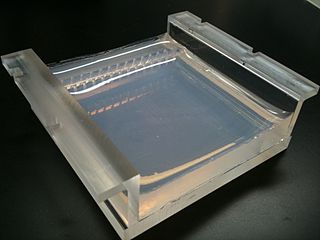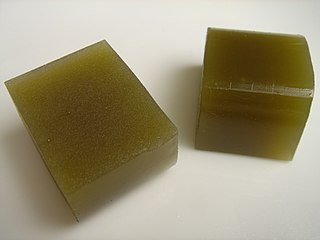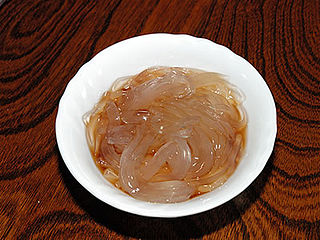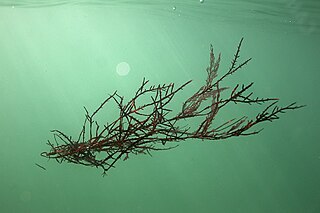
Agarose is a heteropolysaccharide, generally extracted from certain red seaweed. It is a linear polymer made up of the repeating unit of agarobiose, which is a disaccharide made up of D-galactose and 3,6-anhydro-L-galactopyranose. Agarose is one of the two principal components of agar, and is purified from agar by removing agar's other component, agaropectin.

Agar, or agar-agar, is a jelly-like substance consisting of polysaccharides obtained from the cell walls of some species of red algae, primarily from "ogonori" (Gracilaria) and "tengusa" (Gelidiaceae). As found in nature, agar is a mixture of two components, the linear polysaccharide agarose and a heterogeneous mixture of smaller molecules called agaropectin. It forms the supporting structure in the cell walls of certain species of algae and is released on boiling. These algae are known as agarophytes, belonging to the Rhodophyta phylum. The processing of food-grade agar removes the agaropectin, and the commercial product is essentially pure agarose.

Chondrus crispus—commonly called Irish moss or carrageen moss —is a species of red algae which grows abundantly along the rocky parts of the Atlantic coasts of Europe and North America. In its fresh condition this protist is soft and cartilaginous, varying in color from a greenish-yellow, through red, to a dark purple or purplish-brown. The principal constituent is a mucilaginous body, made of the polysaccharide carrageenan, which constitutes 55% of its dry weight. The organism also consists of nearly 10% dry weight protein and about 15% dry weight mineral matter, and is rich in iodine and sulfur. When softened in water it has a sea-like odour. Because of the abundant cell wall polysaccharides, it will form a jelly when boiled, containing from 20 to 100 times its weight of water.

Carrageenans or carrageenins are a family of natural linear sulfated polysaccharides that are extracted from red edible seaweeds. Carrageenans are widely used in the food industry, for their gelling, thickening, and stabilizing properties. Their main application is in dairy and meat products, due to their strong binding to food proteins. In recent years, carrageenans have emerged as a promising candidate in tissue engineering and regenerative medicine applications as they resemble native glycosaminoglycans (GAGs). They have been mainly used for tissue engineering, wound coverage, and drug delivery.

Agarwood, aloeswood, eaglewood,gharuwood or the Wood of Gods, most commonly referred to as oud or oudh, is a fragrant dark resinous wood used in incense, perfume, and small carvings. It is formed in the heartwood of Aquilaria trees when they become infected with a type of mold and secrete a resin to combat the mould. Prior to infection, the heartwood is odourless, relatively light and pale coloured; however, as the infection progresses, the tree produces a dark aromatic resin, called aloes or agar as well as gaharu, jinko, oud, or oodhaguru, in response to the attack, which results in a very dense, dark, resin-embedded heartwood. The resin-embedded wood is valued in East and South Asian cultures for its distinctive fragrance, and thus is used for incense and perfumes.

A growth medium or culture medium is a solid, liquid, or semi-solid designed to support the growth of a population of microorganisms or cells via the process of cell proliferation or small plants like the moss Physcomitrella patens. Different types of media are used for growing different types of cells.

Gellan gum is a water-soluble anionic polysaccharide produced by the bacterium Sphingomonas elodea. The gellan-producing bacterium was discovered and isolated by the former Kelco Division of Merck & Company, Inc. in 1978 from the lily plant tissue from a natural pond in Pennsylvania. It was initially identified as a gelling agent to replace agar at significantly lower concentrations in solid culture media for the growth of various microorganisms. Its initial commercial product with the trademark as Gelrite gellan gum, was subsequently identified as a suitable agar substitute as gelling agent in various clinical bacteriological media.

A thickening agent or thickener is a substance which can increase the viscosity of a liquid without substantially changing its other properties. Edible thickeners are commonly used to thicken sauces, soups, and puddings without altering their taste; thickeners are also used in paints, inks, explosives, and cosmetics.

Gelidium is a genus of thalloid red algae comprising 134 species. Its members are known by a number of common names.

Gelidium amansii, also known as umutgasari, is an economically important species of red algae commonly found and harvested in the shallow coast of many East Asian countries including North and South Korea, China, Japan, Singapore, and northeast Taiwan. G. amansii is an important food source in East Asian countries and has been shown to have medicinal effects on dieting. Hence, in folklore medicine G. amansii is used to treat constipation. This algae is used to make agar, whose components are the polysaccharide agarose and agaropectin, from the large amount of algin which is located in the algae's cell wall, as well it is sometimes served as part of a salad, puddings, jams, and other culinary dishes in producing regions. Agar is a gelatinous substance that is commercially used both as an ingredient in gelatinous desserts and as an incubation matrix for microbes and other products that require an ecologically friendly gelatinous matrix. G. amansii can be purple, red, to yellowish-red because it contains the class of pigments known as phycobiliprotein. Its branching body is cartilaginous and can grow up to a height of 8 to 30 cm or 3 to 12 in. G. amansii may have four or five opposite, compound-lobed, pinnate leaves on each branch. It is uniaxial with an apical cell and whorled cells coming from the axial towards the exterior of the algae. The pith is compacted with apical cells and the epidermis is formed by rounded whorled cells. G. amansii is being studied as a cheap biofuel.

Gulaman, in Filipino cuisine, is a bar, or powdered form, of dried agar or carrageenan used to make jelly-like desserts. In common usage, it also usually refers to the refreshment sago't gulaman, sometimes referred to as samalamig, sold at roadside stalls and vendors.

Seaweed, or macroalgae, refers to thousands of species of macroscopic, multicellular, marine algae. The term includes some types of Rhodophyta (red), Phaeophyta (brown) and Chlorophyta (green) macroalgae. Seaweed species such as kelps provide essential nursery habitat for fisheries and other marine species and thus protect food sources; other species, such as planktonic algae, play a vital role in capturing carbon, producing at least 50% of Earth's oxygen.

Red algae, or Rhodophyta, are one of the oldest groups of eukaryotic algae. The Rhodophyta comprises one of the largest phyla of algae, containing over 7,000 currently recognized species with taxonomic revisions ongoing. The majority of species (6,793) are found in the Florideophyceae (class), and mostly consist of multicellular, marine algae, including many notable seaweeds. Red algae are abundant in marine habitats but relatively rare in freshwaters. Approximately 5% of red algae species occur in freshwater environments, with greater concentrations found in warmer areas. Except for two coastal cave dwelling species in the asexual class Cyanidiophyceae, there are no terrestrial species, which may be due to an evolutionary bottleneck in which the last common ancestor lost about 25% of its core genes and much of its evolutionary plasticity.

Edible seaweed, or sea vegetables, are seaweeds that can be eaten and used for culinary purposes. They typically contain high amounts of fiber. They may belong to one of several groups of multicellular algae: the red algae, green algae, and brown algae. Seaweeds are also harvested or cultivated for the extraction of polysaccharides such as alginate, agar and carrageenan, gelatinous substances collectively known as hydrocolloids or phycocolloids. Hydrocolloids have attained commercial significance, especially in food production as food additives. The food industry exploits the gelling, water-retention, emulsifying and other physical properties of these hydrocolloids.

Seaweed farming or kelp farming is the practice of cultivating and harvesting seaweed. In its simplest form farmers gather from natural beds, while at the other extreme farmers fully control the crop's life cycle.

Tokoroten is a dish in Japanese cuisine made from agarophytes. Tokoroten has been eaten by the Japanese for over a thousand years. Tokoroten is thought to have been introduced to Japan from China during the Nara period. Tokoroten was traditionally made by boiling tengusa and then allowing the mixture to congeal into a jelly.
Agaropectin is one of the two main components of agar and mainly consists of D-glucuronic acid and pyruvic acid.

Gelidium sesquipedale is a commercially important species of red algae. It is a thalloid seaweed, branching on a single axis. A clonal species, it grows in stands on rocky bottoms in the subtidal zone in areas with high water movement and exposed to wave action.

The Pterocladiaceae is a small family of red algae containing 2 genera of agarophytes.













